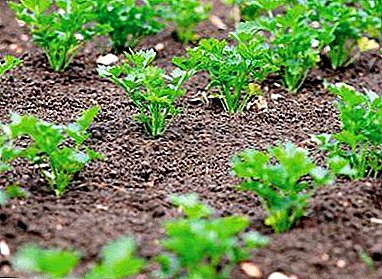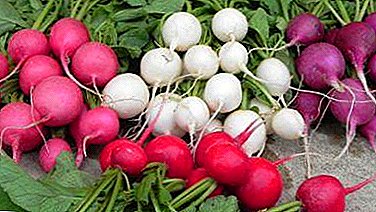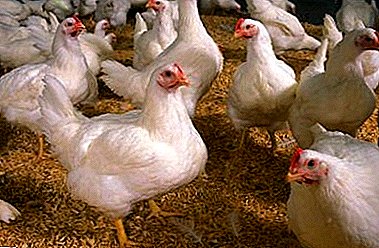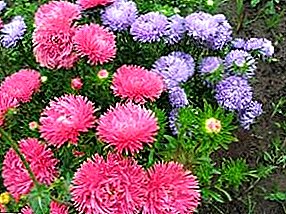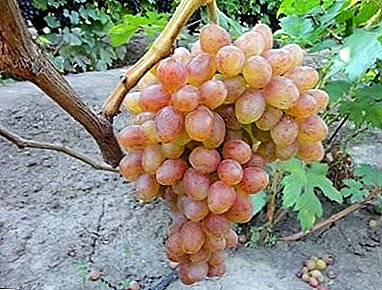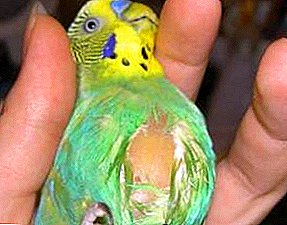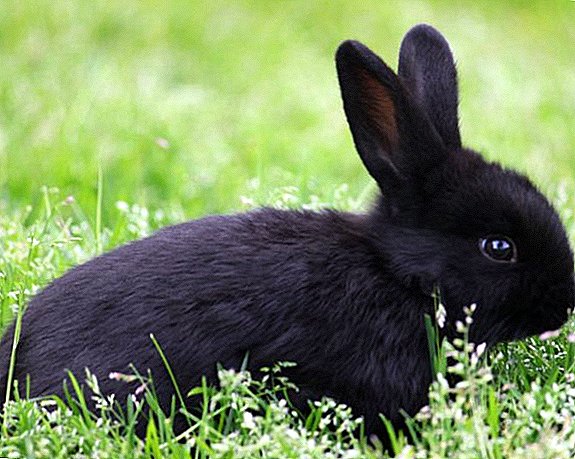 The domestic rabbit is an animal, valuable not only for its fur, fat and meat, but also for its peace-loving character and simple maintenance, therefore this animal is not only raised on farms for industrial purposes, but also raised as a pet. There are about a hundred breeds of rabbits, but black ones are considered the most valuable. In this article we consider the distinctive features, the rules of care and feeding, as well as a description of the most popular black breeds of rabbits.
The domestic rabbit is an animal, valuable not only for its fur, fat and meat, but also for its peace-loving character and simple maintenance, therefore this animal is not only raised on farms for industrial purposes, but also raised as a pet. There are about a hundred breeds of rabbits, but black ones are considered the most valuable. In this article we consider the distinctive features, the rules of care and feeding, as well as a description of the most popular black breeds of rabbits.
Distinctive features of black rabbits
The huge popularity of black rabbits brought them a rich, brilliant, dark coat color. A fur coat made from natural black rabbit fur is in great demand among manufacturers of fur products (especially for short-haired breeds). In addition, dark breeds of baby rabbits differ somewhat more precociously in comparison with their light relatives.
Especially prized are those rabbits that have a uniform monochromatic coat color. The main distinctive feature of all black (and brown and dark chocolate) rabbit breeds is precisely their dark down and fur, which is valued at the market many times more than similar light-colored fur.
Did you know? The color of the rabbit depends on which genes prevailed during its conception. So, the rabbit of pure black color carries the genotype "BB" - two dominant genes at once. For comparison: the genotype "BA" (the dominant gene + the agouti gene) means that there will be black stripes on the wool color. The chocolate shade of wool is achieved by folding the genotype "bb" - two recessive genes.
Popular breeds of black rabbits
Purely black and dark rabbit breeds are quantitatively somewhat inferior to light breeds - there are about 20 species. The best breeds of black rabbits and their characteristics will be considered in more detail.
Black giant
This breed has received such a name for a reason - this is perhaps the largest species among all dark rabbits.  Has such characteristic external signs:
Has such characteristic external signs:
- weight: adults - from 4.5 to 8 kg, and the males are somewhat heavier (up to 8.5 kg). The average weight of females remains in the range of 5.5-6 kg;
- body length: 60-75 cm;
- color: black, uniform, sometimes with brown tint;
- coat length: short-haired breed, hair length up to 2 cm;
- head: large, with thick ears of medium length;
- eyes: dark, round;
- neck: short, strong, well built;
- chest: well developed, wide. The girth of the chest is on average 38-40 cm;
- paws: thick, strong, massive (especially in males);
- okrol: on average, 7-8 rabbits, which differ in precocity (by 3 months they can weigh 2 kg);
- slaughter age: 8-14 months;
- meat yield: net yield of one-year-old black giant meat is about 4.5-6 kg.
Important! Breed black giant does not differ in quality of meat of high level - this type of rabbits is bred first of all because of the first-class fur, down and skins.
Black New Zealand
A relatively new species, bred only in 1981. This rabbit is not yet common in all European countries, therefore, it is not so easy to acquire such a breed for cultivation and sale.  However, according to the forecasts of breeding rabbits, this situation will be corrected within 5-7 years, and the Black New Zealand breed will be distributed to all large European rabbit farms.
However, according to the forecasts of breeding rabbits, this situation will be corrected within 5-7 years, and the Black New Zealand breed will be distributed to all large European rabbit farms.
Get acquainted with the best meat, decorative, fur and down rabbit breeds.
Distinctive features of this species are:
- weight: up to 5 kilograms in adult males and up to 4.5 in females;
- body length: up to 55 cm;
- Color: Blue-black fur, without brown or red hair;
- coat length: not less than 4 cm, therefore, refers to the long-haired. Thanks to this length and density of hair, New Zealanders look bigger and heavier than their real weight;
- head: large, heavy. Ears are V-shaped, up to 12 cm long;
- eyes: large, dark, round (slightly convex);
- neck: mild, wide;
- chest: stocky, wide, strong and fleshy. Girth - up to 33 cm;
- paws: thick, strong, with a wide pad;
- okrol: 5-6 rabbits;
- slaughter age: at least 12 months;
- meat yield: one year old New Zealander gives up to 4.5 kg of pure meat.

Viennese black
This breed exists just under a hundred years old - it appeared by crossing the Alaska breed and blue rabbits. It has not only excellent hair, but also nutritious and tasty meat.
Did you know? Viennese black rabbit is a breed with an ideal ratio of body parameters, quality of fur and developed muscles. Differs in elegance and the smooth, "cat" line of a back. It is the Vienna black breed that most often wins at competitive rabbits shows.Characteristic features of the species are:
- weight: up to 5.5 kg males. Females usually weigh 4.5–5 kg;
- body length: 45-50 cm;
- Color: saturated black uniform fur with a metallic, brilliant shade;
- coat length: hair up to 2-2.5 cm (applies to shorthair);
- head: somewhat large in comparison with the body, heavy. The ears are V-shaped, their length is on average 11-12 cm;
- eyes: the correct form, slightly convex. Mostly dark color;
- neck: weakly expressed, smoothly flows into the back, forming a beautiful cat's bend;
- chest: very broad and powerful, muscular. Volume - 32-36 cm;
- paws: relatively small, wide and strong;
- okrol: 5-7 rabbits;
- slaughter age: 11-14 months;
- meat yield: about 4-4.5 kg of pure meat.

Black brown
Type of rabbits, bred in Soviet times (around 1942). The main prerequisites for the emergence of this type was good resistance to low temperatures and some diseases.
The demand for rich black fur at that time was caused by the huge demand for clothes and furs made from fox blackfoil; therefore, domestic breeders were faced with the task of bringing out black breed of rabbits with thick, high-quality wool, which would not lose its taste. It was possible to solve this problem by crossing the White Giant, Flandre and Vienna Blue breeds.
Read more about the rules of keeping and feeding rabbits of black-brown breed.
The black-brown appearance of rabbits has such distinctive features:
- weight: maximum - up to 7 kg. The average weight approaches 5.5 kg in males and 4.5-5 kg in females;
- body length: 45-55 cm;
- Color: black with brown splashes (can be either spotty or “divided” into colors - for example, the head and chest are black, and the body and tail are brown);
- coat length: up to 3 cm (refers to breeds with an average length of wool). Differs incredibly thick fur - up to 23,000 hairs per 1 cm of skin;
- head: powerful, proportional to the body. Ears long (up to 12 cm), stand straight;
- eyes: dark, large, may have a slightly elongated incision;
- neck: wide, small, smoothly flows into the body;
- chest: broad, muscular, may have an additional demox;
- paws: long, powerful, straight. The pads are wide and strong;
- okrol: 5-8 rabbits;
- slaughter age: 10-13 months;
- meat yield: net to 5.5 kg.
 As a rule, the back and head of black-brown rabbits have a uniform black color, while the brisket and legs are brown-brown. This type is famous for top quality wool and excellent thick down (there are about 45 fiber down threads per hair spine).
As a rule, the back and head of black-brown rabbits have a uniform black color, while the brisket and legs are brown-brown. This type is famous for top quality wool and excellent thick down (there are about 45 fiber down threads per hair spine).Important! Such types of rabbits as the Vienna Black and New Zealand Black are highly valued for their uniform color. Sometimes representatives of these species come across hairs of red or chocolate color, which unscrupulous farmers simply pluck out with tweezers so that the value and value of the breed does not decrease during implementation. When buying animals of these species, carefully inspect the animal's hair: the presence of even small bald spots may indicate that this animal has pulled out hairs of a lighter color. If you get into such a situation, do not hesitate to bargain and demand a lower price: remember that the presence of light hairs or hair sections in the breeds mentioned above indicates the unclean appearance of the species or the presence of certain diseases.
Black fire
Bright and very beautiful view, derived in England at the end of the XIX century. These frisky and playful animals were bred by breeding the Belgian giant with wild local rabbits.  Representatives of the black-fiery species have the following characteristics:
Representatives of the black-fiery species have the following characteristics:
- weight: adult males up to 3.5-4 kg (applies to medium-sized species). Females can gain weight up to 3 kg;
- body length: 35-38 cm;
- Color: dark, with bright fiery areas in the area of the abdomen, nose, and outer rim of the ears. This combination of the main dark color with a contrasting red gives the brightness and saturation of this breed;
- coat length: shorthair view. Hair length - up to 2 cm;
- head: small, compact, of the correct proportion, slightly elongated. The ears are erect, 10-11 cm long;
- eyes: small, rounded, often dark in color;
- neck: short, smoothly flows into the back;
- chest: small and narrow. The back is beautiful, with a smooth bend;
- paws: strong, strong, well set. The pad is soft and wide;
- okrol: 4-5 baby rabbits;
- slaughter age: not less than 12 months;
- meat yield: up to 3 kg of pure meat.
Learn more about black fire rabbits.
Just like in other dark breeds, the presence of light single hairs in a black-fire rabbit is considered to be a breed marriage. 
Care and feeding
Care and maintenance of dark breeds of rabbits is no different from the care of their light-colored breeds. The basic rules in keeping any breed of rabbit are balanced nutrition, daily walks and protection from drafts.
We advise you to read about how to water the rabbits with water, what supplements you need to give them, how to feed the rabbits, what grass to feed the rabbits, and also find out what vitamins the rabbits should be given.
The main nuances in the content of these fluffy animals:
- Food. The presence of both dry grains and hay (as well as pumpkin and sunflower seeds, nuts, chalk and granules), as well as juicy grass, vegetables, some fruits (apples), and the ratio of dry / juicy food should ideally be 1 part dry food. 2-3 juicy.
- Water. Even with round-the-clock access of animals to fresh grass and juicy vegetables, they urgently need ordinary drinking water (just not cold). With a lack of moisture in the body of the animal, irreversible processes will occur that can lead to the death of the rabbit. Moreover, the mortality of newborns or bouts of cannibalism in the female (when she eats her offspring) occur precisely because of the lack of water in the body.
- The amount of food. A rabbit is an animal that always eats, day and night. His chewing instinct is very well developed, so with a lack of food he will begin to eat around wood, plastic, cardboard and everything that gets in his way. Because of this craving for chewing, these animals are prone to overeating. About 200 g of hay, 150 g of grain and 0.4 kg of fresh grass are considered to be a daily standard for a three-kilogram rabbit.
- Grazing. Rabbits need constant motor activity, so they need enough space for walking. If the animal is caged at home, it should be let out for a walk of at least 20 minutes daily.
- Draft protection. Heat and drafts are the main enemies of these animals. The maximum temperature for the animal is + 25 ... +27 ° C, so on hot days it is necessary to provide the animal with shelter from direct sunlight (build a canopy or a special house). Draft, especially in the cold season, can lead to illness and death of the animal - so fix the cracks in the rabbit or insulate it (at least in winter).
The popularity of black breeds of rabbits is due to their characteristic, dark coloring - it is these breeds that receive prizes in various competitions. Nevertheless, their content is as easy as light species - even a novice farmer can cope with this.



